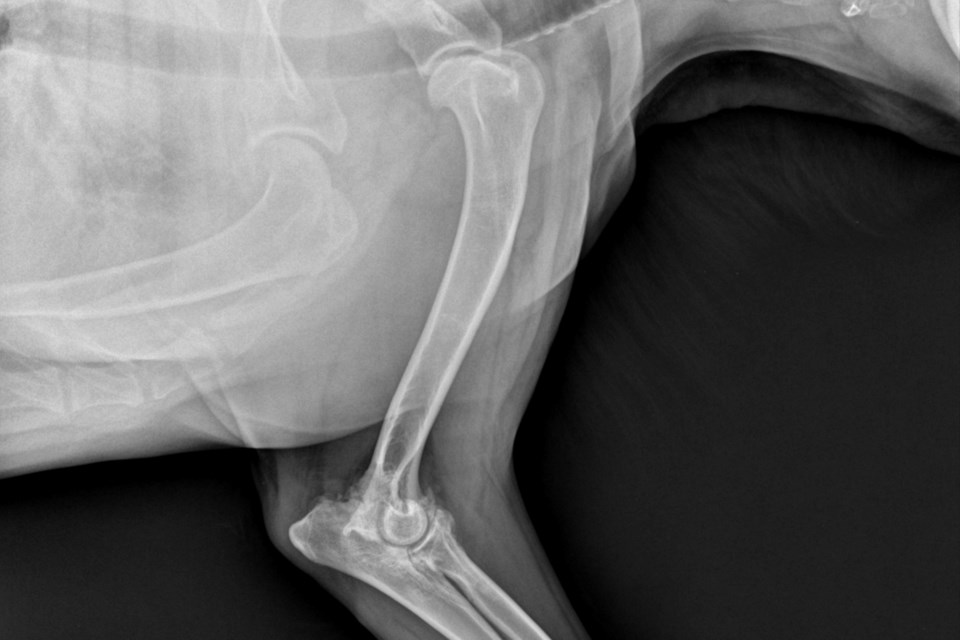I have a geriatric dog, admitting it is the first step. Though I constantly refer to him as “my baby”, Einstein is a nine-year-old Australian Shepherd mix, who has been limping after exercise, and suffers intermittent pain in his right hip and occasionally drags his back nails when walking.
Einstein has arthritis, like at least 25 per cent of dogs. The signs noted above are common things heard from owners in the exam room.
But what about cats? Most cat owners aren’t telling me that Minou is limping after her walk because most cats don’t go for walks and fundamentally they don’t show pain like dogs. Cats show pain with behaviour changes: staying on one floor, hiding, taking two jumps instead of one, or stretching to decrease the height of a jump when getting off the counter.
Even something as small as increased hesitation when going to make a jump is a sign of arthritis. Arthritis is grossly under-diagnosed and treated in cats. One study found that 90 per cent of cats over the age of 12 had radiographic signs or arthritis — 90 per cent!
I doubt that 90 per cent of owners of older cats would think that their cats have arthritis, or are in pain. They are masters at hiding pain.
Arthritis or degenerative joint disease is an irreversible and progressive condition of the joints due to loss of joint cartilage. Cartilage starts to break down, which increases friction in the joint, leads to inflammation, which breaks down more cartilage and the cycle continues.
If it’s progressive and irreversible what can we do about it?
While we can’t cure arthritis, we can manage it and slow down the progression. Still, there is no magic pill; it requires a multi-modal approach and ideally intervening before signs are obvious.
The cornerstone of arthritis management is weight management. In cats and dogs, being overweight predisposes them to a host of issues, but early onset of arthritis is by far the most common.
If your pet is overweight, your veterinarian and veterinary technician can calculate a weight loss food ration for you or recommend a specific diet that can help. It can also help to weigh your pets food daily instead of using a measuring cup. It’s more accurate and you might be surprised how just a few extra calories daily add up.
For example, Argyll, my two-year-old Cairn terrier, is about two kilograms overweight, which doesn’t sound like much until you know he’s only supposed to weigh nine kilograms. He is now on diet food that I weigh for him every morning. He is my high-maintenance boy.
Joint supplements such as omega-3 fatty acids, glucosamine and chondroitin-sulfate are often associated with arthritis management for good reason. Glucosamine and chondroitin-sulfate are actually “chondroprotective”; they support cartilage, and help slow down its breakdown.
They are often started when signs are already present, but are more helpful when started early, if there is already too much damage to the cartilage there may not be much improvement seen. Omega-3 fatty acids have been shown to reduce inflammation and aid in both protection and treatment of signs of arthritis.
As arthritis progresses pain relievers may be required. Non-steroidal anti-inflammatory drugs (NSAIDs) are the most commonly prescribed drug type. They have the potential for side effects (vomiting and diarrhea, for example) and long-term use can affect other organ systems.
Remember, dogs and cats are not small humans. They metabolize medications differently and most human NSAIDs can be toxic at low doses, so always consult your veterinarian before starting any pain relievers. There are new modalities becoming available for cats and dogs that are showing great promise with few side effects, which is exciting news. Your veterinary team can tell you more.
The bottom line is arthritis is going to affect the majority of our pets, but there are many things that you can do as an owner to help decrease the severity and progression of the condition to help your pets have the best quality of life for as long as possible. Your veterinary team is there to help you tailor a management strategy to the needs of your pet.
Dr. Courtney Andrews is a veterinarian at Lockerby Animal Hospital, a graduate of the Royal School of Veterinary Studies and dog mom to Argyll and Einstein. Animals & Pets is made possible by our Community Leaders Program.



